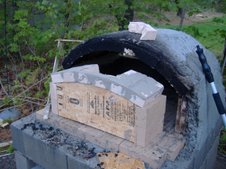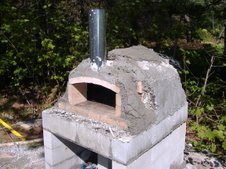Wood-fired brick ovens are more complex than your standard kitchen oven. Modern brick ovens consist of several parts; the base, the chamber, the roof, and the door.
The BaseThe base acts as the interface with the earth, a chamber for the conditioning and storage of wood fuel, and an insulting blanket to minimize heat loss from the oven’s chamber. It is essentially a steel-reinforced masonry chamber. The insulating blanket is provided by including a layer of lightweight sand below the surface of the chamber. Sand has a low coefficient of thermal conductivity, resulting in a high temperature drop across the layer, maintaining the oven’s heat.
The ChamberThe chamber is typically in the form of a tunnel or a dome. These forms provide structural stability as well as concentrating the radiative heat energy on certain areas of the floor of the chamber. The chamber is constructed with refractory materials; either fire brick or refractory mortar. Food is cooked directly on the floor of the chamber. Because of the high temperatures that brick ovens operate at, the oven burns off any oily deposits and is self-cleaning.
The RoofA large mass of concrete is placed above the chamber, forming the roof. The concrete absorbs the heat that passes through the top of the chamber. The energy contained in this heat is radiated downward back into the chamber, cooking food even in the absence of flame. The more concrete, the more energy is retained.
Because of the potential for differences in thermal expansion, a membrane is placed between the refractory masonry and standard masonry materials in the concrete mass.
The Chimney-Door AssemblyThe Chimney-Door assembly is the opening to the oven. The opening is extended in order to allow the placement of a chimney at a high point that vents exhaust gases up and away from the baker’s face during operation. The height of the door is lower than the height of the chamber. The difference in height creates a heat pocket in the chamber, allowing the energy from the fire is transferred from the exhaust gases, through the chamber, to the concrete mass of the roof. The ratio of the door height to the chamber height should be approximately 0.62 for effective operation. A metal door cover can be placed to retain heat with in the chamber.
Brick Oven Thermodynamics Brick ovens are extraordinarily energy-efficient devices. Compare the efficiency of a standard electric range with that of a brick oven.
Electric ranges use electricity. Electricity is made by burning fuel, heating up water, and spinning turbine generators. The process has a thermal efficiency of around 33%, meaning that two-thirds of the energy used in the generation of electricity is wasted. Following power generation, more energy is wasted in line losses during transmission from the power plant to your house. Once inside your house, more energy is wasted during cooking. After all is said and done, perhaps 15% of the energy put into the electrical generation plant ends up cooking your food. Your Weber grill is lucky to hit 10%.
In comparison, a properly operated brick-oven’s energy efficiency is up to 90%. And the fuel comes from fallen wood in your backyard.
Conduction, Convection, and Radiation: Why brick ovens are better.The oven in your kitchen operates by conduction. If you turn the temperature to 425F, the air within the oven heats up and food in the oven slowly comes to temperature as the heat is absorbed. Since the air within an oven is relatively still, a ‘temperature gradient’ develops around the food, acting as insulation and slowing the cooking process.
High-end commercial pizza ovens offer blower-based convection technology. A convection oven passes moving air over the food to cook it. By using moving air instead of stagnant air, the temperature gradient surrounding the food is greatly reduced, cooking is made more rapid, and most pizza purveyors consider the finished product to be of a higher quality.
The venerable brick oven does one better. The brick oven itself is a natural convection device. Air is drawn into the bottom of the chamber and moves to the flames. The exhaust gases from the fire at the rear of the stove rise to the top of the chamber, move forward towards the front of the oven, down to the chimney-door assembly, and then up the chimney. No blowers required.
In addition to the natural convection feature of the brick oven, the extremely hot surfaces of the chamber create a significant amount of radiant heat. Radiant heat transfers energy through natural electromagnetic radiation, similar to how the sun heats the earth, or how a steakhouse broils a steak.
A brick oven utilizes both convection and radiation as cooking mechanisms, creating excellent food.
















